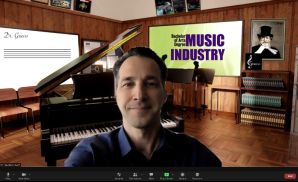A little over a year ago when the pandemic started, professors faced challenges with teaching classes on a fully remote platform. Many of these issues come from professors working to adapt all the online changes and getting used to the technology. Even now a year later, some professors are having difficulties with teaching fully online. With remote learning bringing challenges across the board for college professors, many are trying to find ways to better adapt to the conditions.

Marie Moser saw herself becoming a math teacher. From her experience with math, she knew that is what she wanted to do without having any back up plans.
Moser has been teaching for 43 years. She spent 40 years teaching at high school and elementary level. During those years, she was a science and reading teacher for 6-8th grade. Moser currently teaches at Cabrini University.
With virtual classes being a reality for a little over a year now, Moser said, “The main challenges with teaching online were getting used to the technology,”
The coronavirus virus pandemic has taken 930 million children out of in-person classes, leaving teachers with no choice but to get used to the online technology.
Once the challenges as far as technology issues and making sure each student has a laptop with good Wi-Fi, weekly meetings with the ITR happened to “Try and solve one of the infinity more problems that we are facing during the pandemic,” Moser said.
“The faculty and staff had to discover what virtual teaching would look like and how to keep students occupied through this challenge,” Moser said.
“Online has been much harder because teachers have difficulties on a daily basis. It is difficult because most of the staff are parents and they have a life to live and it is hard trying to balance their households, teaching career and now teaching their own children is a bit tricky thing to do.” Moser said.
“I have a son who is physically challenged, and I must think of his safety as well as mine and my students. I do like the hybrid model with fewer students in the classes and I believe students are learning well with this model.”
Moser likes the hybrid model schedule but worries about the students who can’t afford to come to class.
“I like the hybrid module because there are fewer students and I believe students are learning well with this model,” Moser said.
Cabrini University’s online teaching started in March 2020 switching from in-person to online virtual learning until August where they came up with the hyflex schedule unless some classes remain all online.
Dr. Nune Grigoryan, assistant professor of communication, has been teaching at Cabrini for two years.

With schools this year starting with online and in-person teaching, Grigoryan has been fully online.
“In the beginning, I did not feel the effect of online teaching as much,” Grigoryan said. “However, the pandemic continued, and I really started missing face-to-face interactions with students. It is vital for me to see students and connect with them and some of it happens offline. So, one of the effects of the online teaching was Zoom fatigue and the lack of class dynamics.” She explained how students lose focus and how difficult it is to get students’ attention.
It was hard from teaching in-person classes and jumping into the online module, “My first year at Cabrini was in 2019 and there was no such thing as COVID when I was able to teach in-person. But now that I teach all online it is still hard for me because I am unfamiliar with tools.”
Grigoryan said participation is a high percentage of a student’s grades, “In in-person classrooms, the teacher can tell who is participating or not, but while online it is difficult because some students keep their cameras off.”
Moser said that it is definitely a hard time with teaching math online because there aren’t enough class discussions and math is a more pencil and paper subject. She was able to see where the problems were.
Students wait until the last minute to reach out if they are having technology issues. “Grading online is something I am not used to, and students turn in work late due to technology issues.”
Teachers had to plan the best way to stay organized and keep students from stressing with barely any time to plan ahead. Moser and students figured out what would be the best decision for each student because she felt that it would be difficult for some students to learn math online.
This is a good way to examine what problems students are having while operating online. “I can deal with online homework but not the quizzes and tests.”
“The major change is doing everything online,” Stephen Grieco, assistant professor of communication, said. “I hate that there is no humor and there are some students that are doing better than others. Students are chatting more because some are shy, so it is easy to send chats personally.”

Grieco said that teachers are facing challenges with students signing in late to classes and them keeping their cameras off without participating.
“I require students to keep cameras on during class so I can make sure everyone understands what I’m talking about. Also, it keeps them engaged.”
Grieco tells students who are struggling with technology to reach out. “I send students an email each week to make sure there aren’t any issues with technology, but if there are I can help extend times and tape lessons.”
Some students seem to be doing better with the hybrid model. Some like the freedom of being online and some are having difficulty with the technology. “I feel as a teacher, I am going through the same issues as students. I do not feel there is much difference. Hopefully COVID will be under control soon.” Moser said.
Professors have been struggling with students not interacting with online participation and missing face-to-face interactions. Some students can’t keep their cameras on for several reasons. Some students do not have access to a webcam, or some do not have high-speed internet.
“Teaching online seemed like an easy transition for me. It was easy partially because of the subject I teach, social media. I started to think about designing course materials using a more interactive interface. I reduced the amount of the content materials, which was challenging since I still had to keep the rigor in place,” Grigoryan said.
“The major change is doing everything online,” Grieco said. “I hate that there is no humor and there are some students that are doing better than others. Students are chatting more because some are shy, so it is easy to send chats personally.”
Many students are more comfortable participating in class using the chat feature as opposed to speaking virtually.
Another change in preparation was increasing group discussions in each class and making meetings shorter.
“I cannot speak for the students’ experiences, because I do not know what each one of them is going through. My impression is that some students adjusted better than others. Students who need a bit more time or help with time management and organization, definitely had a more difficult transition.”
“One thing I’m going to do differently for Fall 2021 is having the lecture and recordings for students to access at any time so they can listen to them before next class and they can go back and forth with it without any expiration,” Grieco said.
“Overall, it’s a different approach trying to get every student involved,” Moser said.


